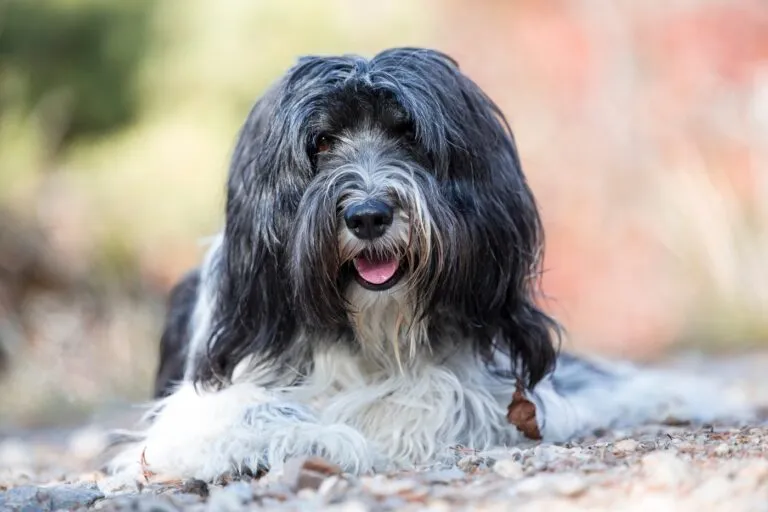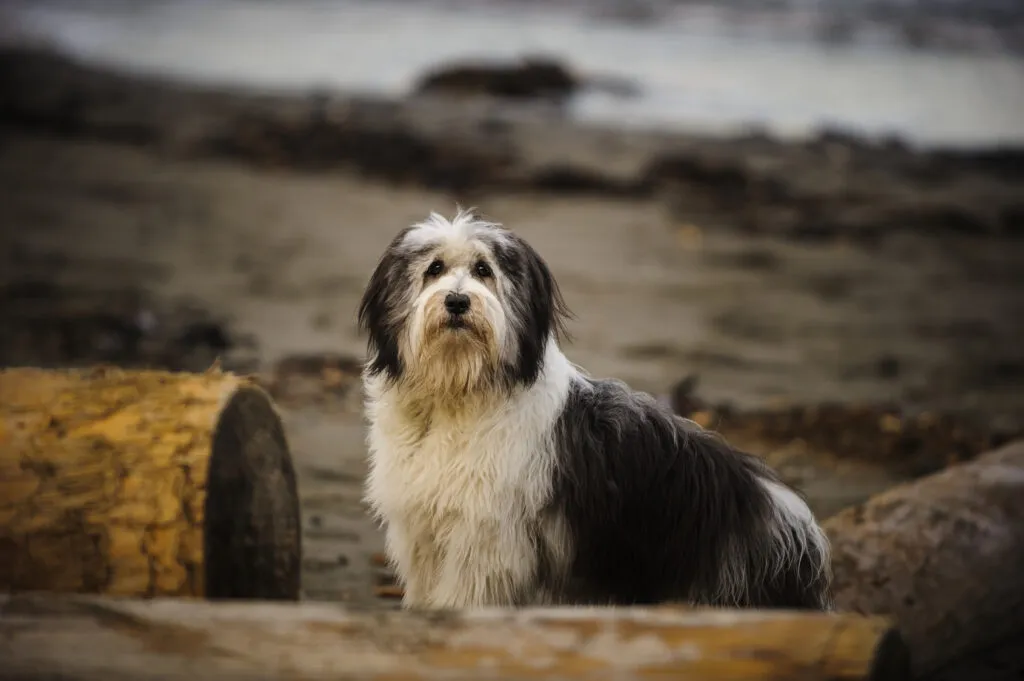Medium Size Poodle
The Polish Lowland Sheepdog, or "PON", officially known as Polski Owczarek Nizinny, brings cheerfulness to any pack. Its friendly nature and appealing appearance are making it increasingly popular among dog lovers. However, if you choose this energetic breed, be prepared to spend a lot of time engaging with it and ideally, have some prior experience with dogs for the consistent yet loving training of this independent creature.

© Jackie / stock.adobe.com
The Polish Lowland Sheepdog is renowned for its intelligence, alertness, and strong bond with its family, making it an excellent herding dog and loyal companion.
The medium-sized, long-haired sheepdog may be easily mistaken for the more familiar Bearded Collie but is slightly smaller, with maximum males reaching a shoulder height of 50cm. It is sturdy and muscular, weighing up to 22kg.
The goat-like fur comes in various colours, either solid or spotted, and has a dense undercoat. Some PONs are born with a shortened rod.
Historically, long tails were often docked to meet breed standards, a practice now thankfully banned in most European countries.
Thus, PONs can proudly wag their long tails according to their breed standard.
As the name suggests, this breed originated from Polish farms where it served as both guardian and herding dog, with roots tracing back to the 13th century. Experts believe that breeds like the Pulis and Tibetan Terrier are among the PON’s ancestors.
According to old accounts, in 1515, Polish merchant Kazimierz Grabski’s herding dogs drew admiration while herding sheep in Scotland. This led to the exchange of a ram and two ewes for a Polish male and two females, which laid the foundation for Scottish herding breeds, including the Bearded Collie that closely resembles the PON.
The breed was showcased for the first time at a dog show in Warsaw in 1924. The breed nearly went extinct during World War II, but thanks to the efforts of veterinarian Dr. Danuta Hryniewicz in the 1950s, today’s PON lines, particularly from the male “Smok”, were established.
In 1959, the FCI recognised the breed. Today, the PON enjoys growing popularity as a companion and family dog, even beyond its homeland.
Intelligent, lively, and highly fit both mentally and physically – the PON embodies typical herding traits. It is loyal to its pack and a reliable guardian that keeps its distance from strangers.
The breed has minimal hunting drive. As an excellent watchdog, it loves to bark, and loudly too. Despite its diligent herding nature, the PON is playful and enjoys being close to its family, appreciating both physical contact and cuddling sessions.
Kennel confinement is not suitable for this social dog.
 © everydoghasastory / stock.adobe.com
© everydoghasastory / stock.adobe.com
This charming dog requires consistent training that lovingly respects its herding instincts and independence. The PON only recognises a competent leader; it is too clever for training mistakes. Effective training involves clear rules for a harmonious human-animal relationship and appropriate engagement.
An under-stimulated herding dog will find its own tasks, quickly derailing training efforts. A balanced PON makes a well-behaved representative of the breed.
Choose appropriate food for your pet with high meat content – it should be the primary ingredient. Avoid pet food with low-quality grain. When your dog joins you, start with its usual food, gradually introducing new food if needed.
Proceed step by step: mix increasing amounts of new food into the familiar food daily, allowing your pet’s stomach to adjust to the new ingredients.
Allow your PON to rest after meals to prevent the risk of gastric torsion. While puppies and pregnant dogs need three to four meals per day, two meals suffice for an adult dog.
Dogs require more calcium than humans, but commercially available pet foods already contain enough. Contrary to popular belief, dogs do not need bones. If you want to offer bones, ensure they are not cooked as these can splinter.
Tread-chewing products like dried cattle ears are a good alternative. Given your PON’s luxurious fur, assessing its body size can be challenging. Weigh your dog regularly to monitor weight changes, as some PONs are excellent at absorbing nutrients and can gain weight quickly.
Manufacturer guidelines are just benchmarks and should be adjusted to your pet’s activity level and constitution.
PONs may be prone to hip dysplasia (HD) and conditions like Progressive Retinal Atrophy, leading to blindness. Additionally, PONs have a higher predisposition to Ceroid Lipofuscinosis, a genetic disorder causing nerve cell damage, seizures, and death, often after vision issues arise at around two years of age.
Since no genetic test exists for this disease, ensure breeders exclude affected animals from breeding. Without genetic predisposition, PONs are robust dogs living up to 14 years.
The long PON fur requires regular, thorough care. Set aside an uninterrupted time weekly, or at least every two weeks after an extended walk, for grooming. Better yet, introduce your puppy to this ritual early on so it learns to enjoy it.
Brush gently for a few minutes daily, and end on a positive note. It’s helpful if your dog lies on its side while you comb through its fur. Grooming also includes trimming ear hair and hair between paw pads to prevent matting.
Most PONs naturally wear down their claws, but check claw length regularly and trim if necessary. If you’re unsure, have your vet or a dog salon do it.
Some owners bathe their PONs every few weeks using mild dog shampoo, which is generally fine. Brushing your dog’s teeth with special toothpaste and a suitable toothbrush from a pet shop can also be part of grooming, helping to prevent tartar.
Regarding household hygiene: While PONs don’t shed much, they do enough to make lint brushes necessary.
These robust herding dogs need ample outdoor engagement, thriving in all weather while taking on tasks and enjoying long walks with their family. Slowly acclimate an adult PON to jogging beside a bike or following a horse.
Consider its independence, and you and your dog can find delight in agility or dog sports like Flyball or Dog Dancing. Some in the breed love fetching while others find it boring – explore what you both enjoy! PONs also shine in rescue dog teams.
Although the PON’s endearing nature and cute appearance capture many hearts, this energetic dog isn’t for everyone. Beginners need to be willing to learn and have a good dog training school in the background.
People who only want to walk around the block on drizzly days should avoid this breed as well. Cleanliness enthusiasts might not suit this breed either, as its dense fur often collects leaves and dirt brought indoors daily.
The PON is less suitable for city living, needing ample space and ideally a large fenced garden to play and guard. Consider carefully if you can offer a PON a suitable home, as this decision involves a big responsibility for the dog’s entire life.
The breed can form wonderful bonds with children if well-socialised and if the children treat animals respectfully. Small children should never be left unsupervised near any dog. Additionally, your PON should always have a retreat when things get too hectic. PONs can also quickly befriend cats within their pack.
Lastly, consider who will care for the dog during your vacations, or whether it can travel with you. Well-trained dogs are increasingly welcome in hotels. The PON, for instance, is an excellent companion on hiking holidays.
Before bringing a Polish Lowland Sheepdog home, budget for the initial costs (buying from a reputable breeder or rescue, toys, lead, harness, collar, beds, bowls, grooming tools, car transport safety gear) and ongoing costs: quality food, dog tax and liability insurance, and regular vet visits. Veterinary costs can increase unexpectedly in case of illness, necessitating financial preparedness.
Ensure the breeder belongs to an association and breeds with lineage proof. A good breeder will happily discuss their breeding goals and health precautions. Visit the breeder’s home to see the puppies and their environment. The parents and puppies should look healthy and sociable. Trust the breeder’s advice on which puppy suits you best – the best fit might be napping during your visit.
Avoid unscrupulous breeders focused on profit over animal welfare. These breeders often produce animals with genetic issues and social deficits due to lack of care, and there’s no guarantee the dog is a PON.
If considering giving an older dog a home, browse the internet for rescue or enthusiast organisations dedicated to herding dogs or specifically to PONs. These groups can match you with a dog suited to your experience and lifestyle.
These “second-hand dogs” are often well-developed personalities, making adoption particularly exciting. Be honest about your dog experience and living conditions during discussions with the organisation to ensure a good match.
We wish you and your Polish Lowland Sheepdog many wonderful adventures together!
Fans of the Bearded Collie agree that those who aren't familiar with this dog breed simply have to get acquainted with it. And those who have experienced how a Bearded Collie bolts across meadows with its flowing fur, how it rolls around full of energy and joy and how it attentively and observantly takes into account its owners wishes become simply addicted to this original dog breed and its unique charm.
The Goldendoodle isn't a breed, but a pairing between Golden Retrievers and Medium or Standard Poodles. Marketed as a low-maintenance dog for allergy sufferers, this hybrid is enjoying increasing popularity amongst dog lovers, similar to the Labradoodle.